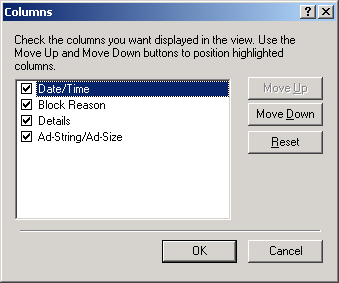Displaying Logs
To view NCF logs, click Tools > Novell Client Firewall Log Viewer. Then select the items of interest in the Console tree as described below, or switch to the Favorites tab.
The Console tree and Information panel are similar to the left and right panels of Windows Explorer. The Console tree is a listing of the filters and the Information panel gives detailed data about whatever filter is selected in the Console tree.
As with Windows Explorer, any line that starts with a plus sign (+) can be expanded to show each of its subcategories. Any line starting with a minus sign (-) shows that the line has already been expanded. By clicking the minus sign, all of its subcomponents can be hidden so only the name of the component is displayed to conserve screen space.
Content in the NCF Viewer changes quickly; therefore, to display the latest data in the Information panel, refresh it occasionally by first selecting the log, preset, or filter you want to refresh in the Console tree and then clicking the Refresh button in the Information panel.
The history of NCF activity is displayed in the NCF Viewer Information panel as a table. Every log has its own set of columns. You can configure the NCF Viewer to show only the columns you are interested in and in any sequence you like.
To select the columns you want displayed for the selected log, open the log as described above. Then right-click anywhere in the Information panel and then click Columns. Alternatively, you can click View > Add/Remove Columns on the Menu bar.
Figure 41
Columns Dialog Box

In the Columns dialog box, check the names of the parameters (columns) you want displayed in the Information panel.
To change the sequence of columns in your log, simply click-and-drag the columns in the Information panel to arrange them in whatever order you want. This can also be done in the Columns dialog box by selecting a column and then clicking the Move Up or Move Down button. To revert to the default order, click Reset.
To resize a column, open the log as described above. Position your cursor over the border of the column's caption. The cursor changes to a double-headed arrow. Click the left mouse button and keep it pressed while moving the cursor. Release the button when the column has reached the size you want.
NCF Log Viewer also lets you sort the records of a log by the values of any column in descending or ascending order. Click the header of the column you would like to use to sort the records. If the header shows an arrow pointing upwards, the records will be sorted in ascending order (1, 2, 3). To reverse the order, repeat the click. The header now shows a downward arrow and the records will be in descending order (...3, 2, 1).To make it easier to locate specific data in a log, you can show or hide records containing the same data in any displayed columns. Select a record in the Information panel, then right-click in the cell that contains the data of interest. From the context menu, select Include Selection to show the records with similar data or Exclude Selection to hide them. If there are other records that have the same data in a cell, you can add that also. To show all records again, select Show All from the context menu.
For example, to view data on connections established by a certain application at a particular time, select the Allowed Connections log, right-click the cell containing the information record for the application in the Application column, then click Include Selection. Then right-click the required date and time in the Start Time column and click Include Selection again. The Information panel will now display all the records of the selected date related to the selected application.
This operation can be done so quickly that there is no reason to save the configuration. To create a permanent selection of records under complex conditions, create a filter.
NOTE: Include Selection and Exclude Selection commands are not available for some logs.
